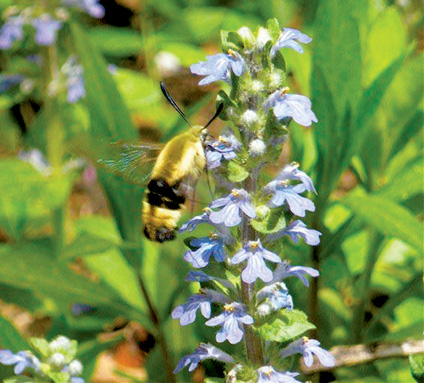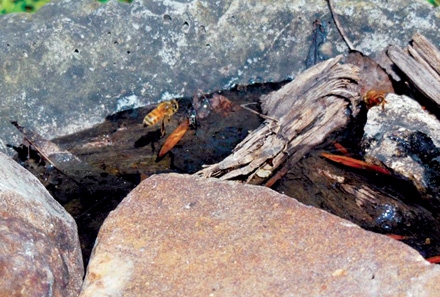How to help pollinators without planting

These are not your standard how to help pollinators suggestions. Write it off to the record hot temperatures we have been having but I don’t think much will survive if we try to plant right now. That doesn’t mean there aren’t things we can do to help pollinators:
1. Just as we need to hydrate in these record hot temperatures, pollinators and other wildlife, as well as pets, need access to drinking water. Whether it’s a plant saucer with rocks, a bird bath or a tiny swimming hole, provide a daily water source. Beekeepers are encouraged to keep a water source for bees within half mile of hives so bees can easily carry water back to the hive. Birds will access water to drink, bathe and keep cool. Butterflies, bats, hummingbirds, and apparently Japanese beetles, need water to stay hydrated.
2. If you see milkweed and other natives you planted earlier dying in these hot temperatures, keep them watered with an underground wand. The deep watering will help keep roots alive and the plants may make a recovery next year.
3. Have plants taking over a garden corner in swaths? Leave them. Many pollinators including bees depend on large swaths of plants for pollen. I know there’s a tendency to want to keep everything nice and neat but that doesn’t necessarily help pollinators. Turf grass takes out a potential source for cover and pollen, most native bees are ground nesters. Why do you want to be out in the garden in these temperatures anyway? Thin out flower beds later in the season when temperatures are more bearable and you can share your bounty with other gardeners.
4. Last but not least, we need to rethink how we use pesticides. I saw my first Japanese beetle drowned in one of my bird baths earlier this week. Instead of using sprays toxic to bees and pheromone traps, which only attract more Japanese beetles, I use a coffee can with a few drops of dishwashing liquid in water to drown the bugs. I will start knocking the bugs out of fruit trees early morning when the bugs are sluggish and hand pick all I can.
I make my own spray, a few drops of dishwashing liquid in a spray bottle full of water. When I need to discourage a bug from my plants, I use this combination. If I need to ramp it up, I add a few drops of hot sauce and apply using gloves so the hot sauce doesn’t get on my hands.
That doesn’t mean there aren’t situations where it is appropriate to use pesticides but please consider other options first. Home gardeners continue to be the leading misusers of pesticides, one of the major causes of the continued bee population struggle.
If you have to use pesticides, please read product labels first. The Environmental Protection Agency has updated their product labels to make it clear when a product is dangerous to specific pollinators. When it comes to Japanese beetles, mixed reviews on what works. All products I have reviewed are “highly toxic” to bees.
Charlotte Ekker Wiggins (hyperlink to www.charlotteekkerwiggins.com) is a certified gardener (hyperlink to www.gardeningcharlotte.com) and beekeeper (hyperlink to homesweetbees.com) Copyright 2016 used with permission, all rights reserved. This material may not be published, broadcast, rewritten or redistributed. Contact Charlotte at chargardens@gmail.com.

FALSE HUMMINGBIRD – Hummingbird moths are often mistaken for baby hummingbirds, both lovely pollinators. This moth is visiting an Ajuga in my garden.

WATERING RUNWAY FOR BEES – Two of my honeybees stop by one of my bird baths to load up on water to take back to the hive. Pollinators, including bees, depend on water for cooling and to make honey. Add rocks and sticks to give them a safe place to land. (Photos by Charlotte Ekker Wiggins).



Facebook Comments